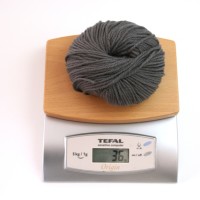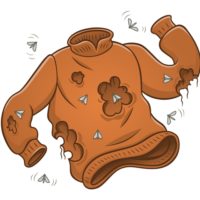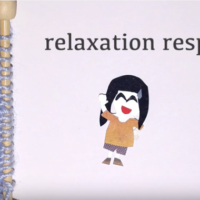Instructions for working Japanese Short Rows:
Turning, knit side:
1. Knit up to the turning point
2. Turn — you’re now on the purl side — and slip the next stitch purlwise from the left needle to the right, so that you working yarn is coming from the stitch on your right needle
3. Attach a pin to the working yarn — the pin should go around the yarn, not through it
4. Continue, ignoring the pin, it won’t be used until the gap is closed
Turning, purl side:
1. Purl up to the turning point
2. Turn — you’re now on the knit side — and slip the next stitch purlwise, from the left needle to the right, so that you working yarn is coming from the stitch on your right needle
3. Attach a pin to the working yarn — the pin should go around the yarn, not through it
4. Continue — if you flip the knitting over, you’ll see the pin attached to a loop
Closing the gap on the knit side:
1. Knit until you reach the gap, clearly marked by the clippie marker between two stitches
2. Grab the clippie and pull the yarn it holds onto the left needle. The loop should be correctly mounted with its right leg in front
3. Knit that loop together with the next stitch on the left needle
4. Remove the pin
Closing the gap on the purl side:
1. Purl until you reach the gap, clearly marked by the clippie marker between two stitches
2. Grab the clippie and pull the yarn it holds onto the left needle. The loop should be correctly mounted with its right leg in front
3. Purl that loop together with the next stitch on the left needle
4. Remove the pin
Information on things you’ll see in the video:
The bulky yarn I used in the sample is Malabrigo Chunky, knit using size 10.5 US needles.
The sweater on the mannequin is my Easy-Knit Sweater Jacket, pattern + video tutorial.
The shawl I’m wearing is the Clapotis pattern, knit with Noro Silk Garden yarn.
The clippie markers I’m using can be found here.
The nail color I’m wearing is CND Shellac polish, in color “Midnight Swim”.







Staci, First off, who knew it would be so easy.. Totally going to try it next time I need to do short rows..
But second.. I love your nails.. lol.. Your hands look great. I think your the only knitting instructor online who actually cares enough to make your hands look fantastic! Really don’t appreciate close ups of dirty fingernails or hangnails!!!
Thanks so much..
Staci, this is fantastic! I totally love this and can’t wait to try it.
Staci–Happy New Year, and Thanks for another great video! I want to replace w&t in a pattern with Japanese short rows; so, I need some clarification. If the pattern says, “K10, w&t” do I K10 & turn or am I actually doing a K11, moving it back to the right after turning and placing the marker? FYI–I can make boiling water complicated! Thanks
Thank you Staci! This is a simple and fantastic technique. Thank you so much for the great demo. You sounded a bit excited to demo this tip. I posted the link on Google+ and sent the link to everyone in my knit group. We all thank you.
Happy New Year to you and your family/friends.
Staci,
So I can use this when I make socks? (turning the heel)
Dear Staci,
Thank you so much for this video lesson. I have been wanting to try the Japanese method. Other insructions made it appear very difficult,but yours are magical! Also, I want to let you know how much I appreciate your patterns and video lessons. They are simply the best! I would have never attempted sweaters or socks without your pattens and tutorials. Lokking forward to trying the new poncho and sweater.
Sincerely,
Nancy
Hi Amy – you’ve got it! You want the turning point to stay in the same spot, so you’ll knit 11.
S t a c i
Shawn – yes, this technique can be substituted any time traditional wraps/turns/picking up wraps is called for in a pattern. I will say this regarding socks…you will have a lot of clippie markers on a very small piece of knitting!
S t a c i
Hi Stacy – Thank you so much for this video. I think I will stop avoiding patterns where short rows are involved! I’ll give it a try. Do you know if I could use this method with garter stitch? Thanks again.
The Japanese short row is too tedious, but thanks for showing this method. I would rather knit wraps and turns. However, I found that the German short row knits faster and I would choose this method from now on.
I commented too soon. I’m knitting the Helix scarf using a lace yarn and noticed that in garter stitch, there is a wider gap between rows with the German short row method compared to the Japanese short row. For nice scarves and garments, perhaps, the Japanese short row method has the best finish—almost invisible garter stitches. The regular short rows create a bump in garter stitch that I don’t like either.
Thanks for all the time you put into this, it’s very appreciated! I have a question for you! I’m having a hard time using Japanese short rows for short rows in a toe-up sock pattern. I’m shaping the toes, but I don’t know how to handle the “double-wrapped” stitches. For short rows the instructions say “When wrapping stitches at turning points of short rows which follow, note that stitches will now have two wraps; these stitches will be referred to as double-wrapped stitches. When working a double-wrapped stitch on a subsequent row, pick up both wraps and work them together with the stitch which had been wrapped.” Anyone knows?
This tutorial was awesome! Used it to figure out set in cap sleeves. Easy & turned out great!
Thanks for this!
I am working a monster pants pattern for a toddler that includes inserting a wide month in a different color using short rows. I understand the short rows for the formation of the mouth. What do I do about the main color? Ignore these rows while I work the short row – that doesn’t seem right. Still a little confused. Thanks.
I’m Knitting the monster longies which requires short rows, I’m confused on how to knit the stitches I’ve placed on hold because it tells me to knit 48 and turn then 38 and turn and then 5 stitches less until I can’t any more and I never come back to the stitches on hold. So it’s very confusing. I think the Japanese short row method is great, but I just can’t figure out how to come back and knit them.
I’ve knit many of the monster longies. It is a bit confusing. If you’re using Das Monster pattern, you knit the mouth color back and forth while ignoring the main color. Read the pattern very carefully. You will put the mouth sts. back on the left needle then start knitting with your main color as though you never left off. I’ve had to read it many many times very carefully befor finally getting it. It helps to use some scrap yarn and practice too.
The nice thing about the monster pants is that if you’ve turned sooner by a st or two it’s not going to make a lot of difference. The idea is to be somewhat symmetrical.
If a pattern instructs you to do wrap and turn short rows to shape the back of a neck of a sweater (knit in the round), would you recommend the japanese or German short rows? would one be preferable – the sweater is stockinette and knit on 5mm needles?